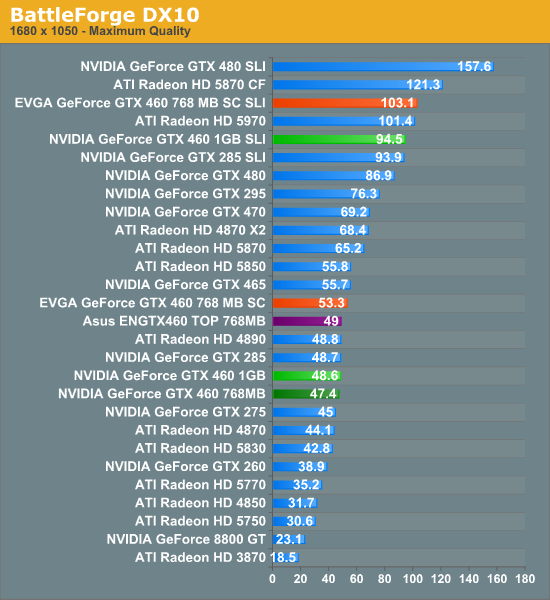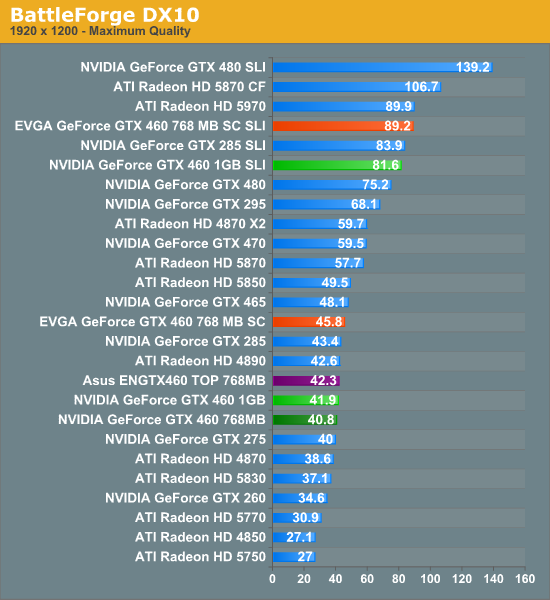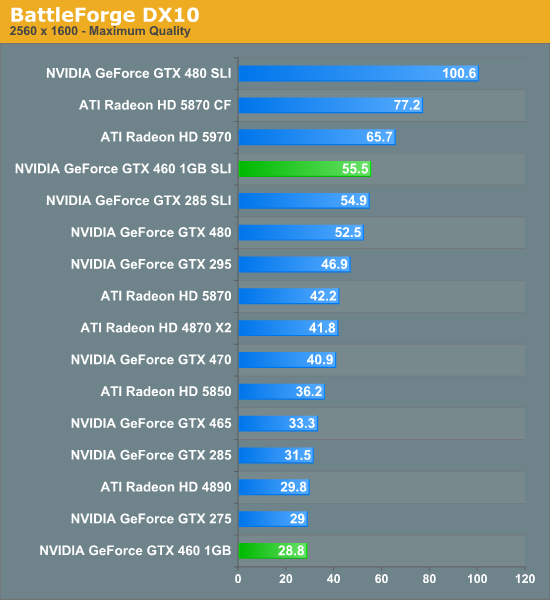NVIDIA’s GeForce GTX 460: The $200 King
by Ryan Smith on July 11, 2010 11:54 PM EST- Posted in
- GPUs
- GeForce GTX 400
- GeForce GTX 460
- NVIDIA
BattleForge: DX10
Up next is BattleForge, Electronic Arts’ free to play online RTS. As far as RTSes go this game can be quite demanding, and this is just at DX10.



BattleForge switches things up some. No longer are we RAM/L2/ROP dependent as much as we are on raw shader power. This gives the 1GB GTX 460 only the slightest advantage over the 768MB card, while the factory overclocked cards clearly dominate here.
This also gives us a situation where we can gauge the GTX 460 and GTX 465 in a shader-bound test and see just how well the GTX 460 can do. The result in the favor of the GTX 465 by quite a bit, where it beats the 1GB GTX 460 by nearly 15%. With the need to extract ILP from the GF104 GPU to fully utilize the GPU’s CUDA cores, this looks to be approaching a worst-case scenario for the GTX 460, as it even falls behind last year’s GTX 275 and Radeon HD 4890.
As for the Radeon 5000 series, AMD’s situation improves here. The 5830 still loses, but only by 10%. Meanwhile the 5850 pulls ahead of the 1GB GTX 460 by 18%.










93 Comments
View All Comments
san1s - Monday, July 12, 2010 - link
I hope this is the card that finally brings price drops, they have been stagnant for far too long.JGabriel - Monday, July 12, 2010 - link
It should. The 768MB version seems to perform about 5% better than the 5830, and the 1GB version comes to ~90% of the 5850.
Just on a performance per dollar basis, that means ATI should drop the 5830 to $189 max, with somewhere in the $170-$180 range being more reasonable, and the 5850 needs to drop down to about $249. Basically, we should be looking at 10%-20% price cuts for the 5670, 5750, 5770, 5830, and 5850.
It should force the GTX 470 under $300, too.
.
medi01 - Monday, July 12, 2010 - link
Best way to drop prices would be to ramp up production. Now, if what I've heard is true (fab treats nVidia as a preferred customer, unlike AMD) we will get yet another round of unfair competition, which in the end will hurt us, customers. :(PS
Is it me, or articles on this side seem quite a bit to be more positive on what nVidia does, than what would feel neutral? Marketing hints like "it’s not a simple reduced version of GF100 like what AMD did" all over... :(
jonup - Monday, July 12, 2010 - link
It is you! Only need to go to the GTX465 review to disptove your point.teohhanhui - Monday, July 12, 2010 - link
Giving credit where it is due?nafhan - Monday, July 12, 2010 - link
Ryan said that because the GF104 isn't a simple reduced version of GF100. Did you notice the part of the article where they talked about superscalar processing? That's not only a marketing bullet point, it's a pretty big change from an architecture point of view, too!medi01 - Tuesday, July 13, 2010 - link
And this detail brings what particular benefit to the user? In particular, contrasting it with competitors (otherwise superior, cooler and faster) solution? Someone makes something wrong, then he has to rework it (the competitor, that did it right from the beginning, doesn't) and this somehow makes he deserve "some credit"?Ben90 - Monday, July 12, 2010 - link
About that "marketing" comment about not a shrink of GF100, its completely true and how does that make this site pro-NVIDIA?You should check out the next article; very first paragraph:
"In 2007 we reviewed NVIDIA’s GeForce 8800 GT. At the time we didn’t know it would be the last NVIDIA GPU we would outright recommend at launch."
medi01 - Tuesday, July 13, 2010 - link
It's completely true, yet it is confusing at best. Piece of silicon is "praised" for something, that has no practical value to the consumer.And please, don't compare nVidia article to nVidia article, compare it to AMD:
When 5830 was reviewed, and mind you, it's a nice card that runs cooler, has eyefinity, but is a tad slower than older 49xx, this fact was PUT INTO TITLE, mind you. It was mentioned in the very NAME of the article, that new 200$ card is a tad slower than older ones. (basically the only "bad thing" that one could say about the card)
In case of 465 it's barely mentioned "oh, it's slower than older 200$ cards".
=(
Lonyo - Tuesday, July 13, 2010 - link
Anandtech is a tech site that often goes more into the under the hood bits.On some sites you will see them calculating performance per currency numbers, or performance per watt.
On Anandtech you will have them discussing things like changes to the architecture, the way the threading works etc.
That's not a new thing, and it's not a biased thing, that's just what they do here at AT in their reviews. It just so happens that the GTX460 has some of those under the hood changes compared to the earlier cards based on the same architecture, so they are discussed in the article.
If you don't care too much about that sort of thing, you can just skip to the benchmarks. If you are interested in it, then it's a nice addition.